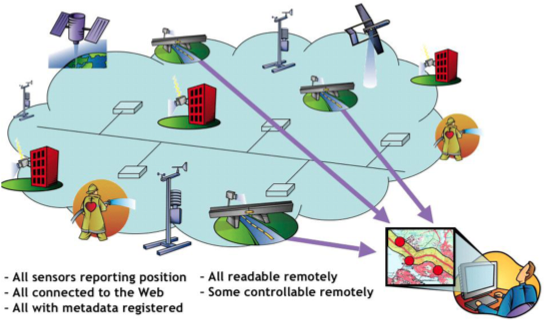-
Enables interoperability among different sensor types, different systems, and different groups:
- Remote sensor vs. in-situ
- Emergency system, utility, defense, science, and intelligence
- Government vs. commercial
- Supports any sensor
- Supports semantic web on-line dictionary and ontology
- Task sensors
- Subscribe to sensor published alerts
OGC SWE’s goal is to discover:
- Sensor systems
- Observations and processes
- Sensor capabilities and quality of measurements
- Sensor parameters that allow software to process and geolocate observations
- Methods to retrieve real-time or time series observations and coverages
(Source: http://portal.opengeospatial.org/files/?artifact_id=25562)
SWE Models
SWE is a Service Oriented Architecture (SOA) open standard providing:
-
Four standard web services interface models
- Sensor Observation Service (SOS) - Fetch observations from a sensor or collection of sensors
- Sensor Alert Service (SAS) - Publishing and subscribing to alerts from sensors
- Sensor Planning Service (SPS) - Requesting user-driven acquisitions and observations
- Web Notification Service (WNS) - Asynchronous delivery of messages or alerts from SAS and SPS web services and other elements of service workflows.
-
Three XML encoding information models
- Sensor Model Language (SensorML) - Standard models and XML Schema for describing sensors systems and processes.
- Observations and Measurements (O&M) - Standard models and XML Schema for encoding observations and measurements from a sensor, both archived and real-time.
- Transducer Markup Language (TML) - The conceptual model and XML Schema for describing transducers and supporting real-time streaming of data to and from sensor systems.
Resources:
* OGC Sensor Web Enablement Tutorials: http://www.ogcnetwork.net/SWE_Tutorials
Images:

